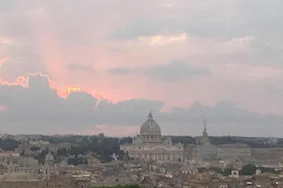Pope Francis marries 20 couples at St Peter's

The was gentle harp music at Peter's Basilica in Rome on Sunday morning, as Pope Francis presided over the marriage of 20 couples from the diocese of Rome. The brides and grooms included people of different ages. Some had been living together. One man's previous marriage had been annulled. One of the women had a child from a previous relationship.
This was the first marriage Pope Francis has conducted in his 18-month papacy. The last wedding to be presided over by a Pope took place under Saint John Paul II in 2000.
During his homily Pope Francis reminded the couples that: "Marriage is real life, not some TV show" and he told them that love of Jesus can help whenever their love “becomes lost, wounded or worn out.”
The official text of the Holy Father’s homily follows:
Today’s first reading speaks to us of the people’s journey through the desert. We can imagine them as they walked, led by Moses; they were families: fathers, mothers, sons and daughters, grandparents, men and women of all ages, accompanied by many children and those elderly who struggled to make the journey. This people reminds us of the Church as she makes her way across the desert of the contemporary world, the People of God composed, for the most part, of families.
This makes us think of families, our families, walking along the paths of life with all their day to day experiences. It is impossible to quantify the strength and depth of humanity contained in a family: mutual help, educational support, relationships developing as family members mature, the sharing of joys and difficulties. Families are the first place in which we are formed as persons and, at the same time, the “bricks” for the building up of society.
Let us return to the biblical story. At a certain point, “the people became impatient on the way” (Num 21:4). They are tired, water supplies are low and all they have for food is manna, which, although plentiful and sent by God, seems far too meagre in a time of crisis. And so they complain and protest against God and against Moses: “Why did you make us leave?...” (cf. Num. 21:5). They are tempted to turn back and abandon the journey.
Here our thoughts turn to married couples who “become impatient on the way” of conjugal and family life. The hardship of the journey causes them to experience interior weariness; they lose the flavour of matrimony and they cease to draw water from the well of the Sacrament. Daily life becomes burdensome, even “nauseating”.
During such moments of disorientation – the Bible says – the poisonous serpents come and bite the people, and many die. This causes the people to repent and to turn to Moses for forgiveness, asking him to beseech the Lord so that he will cast out the snakes. Moses prays to the Lord, and the Lord offers a remedy: a bronze serpent set on a pole; whoever looks at it will be saved from the deadly poison of the vipers.
What is the meaning of this symbol? God does not destroy the serpents, but rather offers an “antidote”: by means of the bronze serpent fashioned by Moses, God transmits his healing strength, his mercy, which is more potent than the Tempter’s poison.
As we have heard in the Gospel, Jesus identifies himself with this symbol: out of love the Father “has given” his only begotten Son so that men and women might have eternal life (cf. Jn 3:13-17). Such immense love of the Father spurs the Son to become man, to become a servant and to die for us upon a cross. Out of such love, the Father raises up his son, giving him dominion over the entire universe. This is expressed by Saint Paul in his hymn in the Letter to the Philippians (cf. 2:6-11). Whoever entrusts himself to Jesus crucified receives the mercy of God and finds healing from the deadly poison of sin.
The cure which God offers the people applies also, in a particular way, to spouses who “have become impatient on the way” and who succumb to the dangerous temptation of discouragement, infidelity, weakness, abandonment… To them too, God the Father gives his Son Jesus, not to condemn them, but to save them: if they entrust themselves to him, he will bring them healing by the merciful love which pours forth from the Cross, with the strength of his grace that renews and sets married couples and families once again on the right path.
The love of Christ, which has blessed and sanctified the union of husband and wife, is able to sustain their love and to renew it when, humanly speaking, it becomes lost, wounded or worn out. The love of Christ can restore to spouses the joy of journeying together. This is what marriage is all about: man and woman walking together, wherein the husband helps his wife to become ever more a woman, and wherein the woman has the task of helping her husband to become ever more a man. Here we see the reciprocity of differences. The path is not always a smooth one, free of disagreements, otherwise it would not be human. It is a demanding journey, at times difficult, and at times turbulent, but such is life! Marriage is a symbol of life, real life: it is not “fiction”! It is the Sacrament of the love of Christ and the Church, a love which finds its proof and guarantee in the Cross.
Source: ICN/Vatican Radio





















